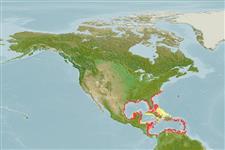>
Gobiiformes (Gobies) >
Microdesmidae (Wormfishes) > Microdesminae
Etymology: Microdesmus: Greek, mikros = small + Greek, desmos = link (Ref. 45335).
Environment: milieu / climate zone / depth range / distribution range
Écologie
marin démersal; profondeur 5 - 10 m (Ref. 10815). Subtropical; 37°N - 8°N, 98°W - 60°W
Western Atlantic: Bermuda, North Carolina (USA), and northern Gulf of Mexico to the Cayman Islands. Eastern Atlantic: only known from two specimens (one extant) from Joal, Senegal (Ref. 10815, 81289). This species’ appearance in brackish waters of West Africa is likely to be very rare, but cannot be discounted (Ref. 81289).
Taille / Poids / Âge
Maturity: Lm ? range ? - ? cm
Max length : 27.0 cm TL mâle / non sexé; (Ref. 7251)
Description synthétique
Morphologie | Morphométrie
Épines dorsales (Total): 19 - 23. Diagnosis: 62-80 (usually 66-75) total dorsal fin rays, including 19-23 spines; 36-52 (usually 40-47) total anal fin rays; anal fin usually originating between verticals from dorsal fin elements 25-31; caudal fin rounded (Ref. 81289).
Coloration: (based on description of juvenile pigmentation, by Smith&Thacker 2000): body tan, with melanophores scattered over flanks and dorsum, forming a stripe on dorsum and a thinner stripe on flanks; mottled pigmentation on head (Ref. 81289).
Known from muddy littoral and estuarine habitats (Ref. 81289). Burrows in shallow muddy and sandy bottoms (Ref. 7251). Postlarvae and early juveniles (to ca 2-2.5 cm SL) may occur in surface plankton to distances of 15 km or more offshore; subadults and adults occasionally found swimming near the surface at night (Ref. 10815).
Life cycle and mating behavior
Maturité | Reproduction | Frai | Œufs | Fécondité | Larves
Robins, C.R. and G.C. Ray, 1986. A field guide to Atlantic coast fishes of North America. Houghton Mifflin Company, Boston, U.S.A. 354 p. (Ref. 7251)
Statut dans la liste rouge de l'IUCN (Ref. 130435)
Menace pour l'homme
Harmless
Utilisations par l'homme
Pêcheries:
Plus d'informations
Noms communsSynonymesMétabolismePrédateursÉcotoxicologieReproductionMaturitéFraiRassemblement de ponteFéconditéŒufsDéveloppement de l'œuf
Taille/ÂgeCroissanceLongueur-poidsLongueur-longueurFréquences de longueursMorphométrieMorphologieLarvesDynamique des populations larvairesRecrutementAbondanceBRUVS
RéférencesAquacultureProfil d'aquacultureSouchesGénétiqueElectrophoresesHéritabilitéPathologiesTraitementNutrientsMass conversion
CollaborateursImagesStamps, Coins Misc.SonsCiguateraVitesseType de nageSurface branchialeOtolithesCerveauxVision
Outils
Articles particuliers
Télécharger en XML
Sources Internet
Estimates based on models
Preferred temperature (Ref.
123201): 23.3 - 28.3, mean 27.2 °C (based on 426 cells).
Phylogenetic diversity index (Ref.
82804): PD
50 = 0.5000 [Uniqueness, from 0.5 = low to 2.0 = high].
Bayesian length-weight: a=0.00102 (0.00046 - 0.00225), b=3.06 (2.88 - 3.24), in cm total length, based on all LWR estimates for this body shape (Ref.
93245).
Niveau trophique (Ref.
69278): 3.9 ±0.5 se; based on size and trophs of closest relatives
Fishing Vulnerability (Ref.
59153): Low vulnerability (17 of 100).
